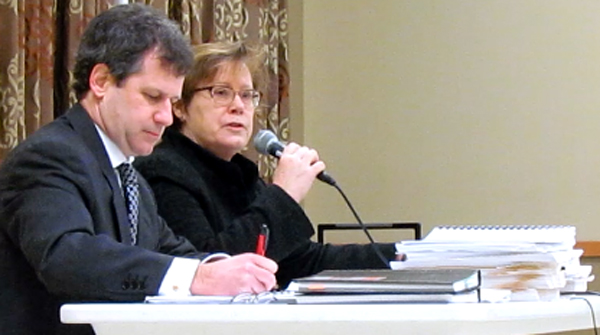Fate of County’s south shore awaits tribunal decision
Administrator | Jan 27, 2017 | Comments 12
Measures to reduce the number of deaths of turtles and bats at the proposed sites of 27 industrial wind turbines on the south shore of Prince Edward County are not acceptable to opponents of the project.
Closing arguments for the Environmental Review Tribunal of the White Pines 27-turbine industrial wind project were heard Friday in Wellington. Verbal submissions on the case were heard from both sides, and tempers flared nearing the six-hour mark over procedural issues involving replies to what was heard throughout the day.
ERT members Marcia Valiante and Hugh Wilkins presided over the proceedings dealing with the Renewable Energy Approval (REA) issued to wpd White Pines, and its appeal by County resident John Hirsch and the Alliance to Protect Prince Edward County (APPEC).
The Tribunal, following a 21-day hearing in December 2015, issued an order in February 2016 that the project “will cause serious and irreversible harm” to animal life and the natural environment – including the endangered Blandings turtles and Little Brown bats. It then ordered a hearing of submissions for potential remedies.
In April 2016, wpd began clearing trees at the sites. A motion to stay construction was granted for areas identified as as the Blanding’s turtle spring foraging habitat pending the resolution of the appeals.
Hirsch, in his statement on Friday, said that following the often contentious 21-day hearing, the decision in February gave Prince Edward County opponents some hope.
“Migratory birds were my key interest, and the tribunal did agree that ‘clearly the project site is poorly choosen from a migratory bird perspective’. But in the end of the initial hearing process, it was once again left to the poor Blandings turtles and the beleagured Little Brown bats to save the day.”
Hirsch spoke about the submissions on the proposed remedies.
“My view is quite simple. wpd has proposed actions which have not been tried before in the real world, and in consequence, are not to be accepted as effective mitigation of the harms found by the tribunal. ”
He summarized wpd’s plan as “Laying down over six kilometres of road improvement using geo-tech plastic, multiple layers of gravel and tilling, grading and removal of vegetation; then, removing all the improvements and attempting to restore the roadway to its former state, they state, with no increased traffic to the project area; monitoring turtle nesting and disturbing their nests.”
Innovative concepts, he said, “but the fact remains, no one has ever tested these measures in respect to the endangered population of Blandings turtles – anywhere, much less in Prince Edward County. These measures have not been tried, or found to be effective… with unintended, or unexpected results.”
wpd council Patrick Duffy spoke of proposed remedies regarding mortality of Blandings turtles on roads, nesting sites and the creation of roads, while co-council James Wilson focused on turbine strikes related to Little Brown bats.
“An expert team has come up with these plans and the approval holder is proud of the plans and the work put into them to achieve objectives in a strong, scientific background,” Duffy said.
With emphasis the project was mostly on private lands, he described an “auto-pilot” component he described as proactive, baseline measures for the life of the project and a “pilot” component of additional monitoring and consultations.
Measures include:
– Timing restrictions of when work can take place
– Signage on roads, training and education on the construction site and site security
– Compacting gravel surfaces to a hardness between asphalt and concrete to make nesting impossible.
– a buried shoulders road design to further deter nesting. Stone would be four to six inches deep, larger he said than what a turtle would nest in.
– Plastic “geo-grid” placed 10cm deep, also to prevent nests which he said average 12cm deep.
– Vegetation with a custom seed mix of native plants along the shoulders to create a dense root zone, also to deter nesting.
– Turtle nest monitoring from May to July, or lengthened periods if necessary.
– Observing roads physically to determine if turtles are nesting, and use of wildlife camera surveillance.
– End of year discussions with Ministry of Natural Resources and Forestry
Duffy said that if turtle eggs were found they would be taken for incubation or a nest cage would be put in place.
He said the plan also addresses public roadway improvements and mortality on the roads to be addressed in the Road Use Agreement signing with the municipality.
The County took its solicitor’s advice last April to sign the agreement which offered a $2.7 million irrevocable letter of credit, “insurance” against damage on the 28km of roads that will be used if the industrial turbine project is allowed to move forward. The document states the County is not a willing host to the project and is entering into the agreement for the sole purpose of protecting the interests of the County.
It is understood that agreement is not yet fully completed with all the documents required but Duffy noted wpd has also committed to it.
Wilson focused on harm to the Little Brown bat noting concern was centred on its active season after sunset in the summer when they feed on insects.
He spoke of feathering wings of turbines and lowering their speeds from sunset to midnight from May 1 to Sept. 30 with variations built in the plan related to the number of bats killed.
“As the level of impact increases, mitigation measures would become more stringent,” he said, noting that would included extended curtailment of turbine blade speed and committee discussion on whether further action was required.
“The correct remedy is to revoke the permit,” said APPEC council Eric Gillespie. “They have to prove successful mitigation measures As Mr. Hirsch said, the issue has not been well studied, we’re guessing in its speculation and going in circles to find evidence… The tribunal can’t rely on that data.”
Calling the proposals new, different and untried, he said they shouldn’t be tested on the County’s wildlife and fauna.
“Overall, I think it’s very clear that the tribunal has a difficult decision,” Gillespie said. “We’re all aware that when this project was first approved, that there was the belief that Green Energy was good and that has changed in terms of turbines. The government has woken up to the fact that we don’t need any more and of the harm they cause… I think the tribunal today came to a better understanding of our clients’ concerns that there just isn’t any evidence regarding all of these proposals.”
The difference between the wpd project and the nine-turbine project that the Prince Edward County Field Naturalists (and Blandings turtle) witnessed victory over last summer, is that the wpd plan is to be built on private lands where Gilead Power’s project involved public land.
“Why did the turtle cross the road? Now we know,” said Gillespie. “Because they can’t read the ERT decisions and realize that one side is OK and the other side is not.”
Valiante told participants a written decision will be issued by the tribunal “as soon as possible, but it is difficult to predict” exactly when.
Filed Under: Featured Articles
About the Author:
































MOE ministry should not be in court defending the harm to wildlife. They should be monitoring information and defending at all costs the environment. When a government ministry takes great strides to oppose the people, we have a serious problem. Do they represent the taxpayer or big business?
MNR
MINISTRY OF NO RESULTS…..
Good luck to our dedicated DD councillors who are meeting with Energy Minister Glenn Thibeau Monday in Toranta…. we are confident that the Strong Breeze Wind Project will meet its demise and be cancelled….
Well put Dennis. The MOE’S conduct is despicable and contemptuous in these hearings. They have broken their oath to protect. So we agree on this, unlike with Trump. He is doing exactly what he said he would do and was elected on. We are not used to a political figure keeping their elected promises.
I first want to thank all those people who have fought the good fight for so many years. I wish you success in this latest and hopefully last battle against IWTs.
What bothers me the most is how our political system has totally failed to protect both people and our environment. If it hadn’t been for those residents of PEC fighting for years, the worst outcome would have happened. No group of residents should have had to go through the time, work and expense that this battle has taken. It has been like the Hundred Years War! It makes me wonder why we have elected representatives who are obviously influenced by big business and our publicly paid employees whose job is to protect the environment with scientific facts – and aren’t allowed to because of our dumb politicians. If everyone was doing their job they were elected and paid to do, none of this fight/appeal process would have been needed and better decisions would be made. Governments at all levels should feel ashamed of their performance in this matter. And they call this democracy.
Once again, thanks to all involved for your hard work!
Perhaps Chris. However I think she shafted Toronto strictly as a political move to gain popularity in the 905 for her next run.
It was shocking to see the vigor employed by the MOECC in its pursuit of McGuinty/Wynne’s undemocratic, so-called “green” energy plan. The lies have been exposed and Wynne’s popularity is at an all time low. She has now shafted Toronto in a cynical attempt to garner support from the 905. Expect her resignation as leader and premier shortly.
I attended the final hearing day on Friday during which each side summarized their case.
At the risk of oversimplifying, Wpd proposed elaborate plans to reduce harms to Blanding’s turtle and little brown bat to acceptable levels — i.e. below “serious and irreversible harm”. The onus is on Wpd to establish that their plans are “more likely than not” to be successful.
Eric Gillespie, APPEC’s lawyer, described Wpd’s proposals as “a grand experiment on.a vulnerable population”. He argued that wpd provided little or no evidence from studies / experience elsewhere that these plans will work and that it is not appropriate to try this experiment here.
I suspect our Government had already made financial commitments to this business making millions off of climate change fears. We are the suckers that pay for one of the biggest scams ever. Given that this is a Tory riding I expect Wynne will want to see the giant useless turbines erected here if for nothing else out of spite.
It’s all irresponsible government nonsense. You have the MOE fighting in court to be able to harm endangered species! We don’t need this energy and if we did, no reasonable person would select an area such as Prince Edward.
Here is a “time line” showing the history of Wind Turbine Noise problems, going back as far as 1979. Each entry provides documentation:
http://cdn.knightlab.com/libs/timeline/latest/embed/index.html?source=0Ak2bgr7C0nhPdGR3S1lEekU3T3p4ZDhUNDdRV2Y2ZkE&font=Bevan-PotanoSans&maptype=toner&lang=en&height=650
1979 “First complaints received from a dozen families within a 3km radius of turbine”.
1981 “Wind turbine operation creates enormous sound pressure waves”
1982 “Closed windows and doors do not protect occupants from LFN”
1982 “NASA research on human impacts provided to wind industry”
1985 “Hypothesis for infrasound-induced motion sickness”
1987 “Wind industry told that dB(A) unsuitable to measure LFN emissions from wind turbines”
…
2004 “Wind industry knows noise models inadequate” (from Vestas)
…
2011 “Vestas knew that low frequency noise from larger turbines needed greater setbacks”
The problem is Wind and Solar are not reducing C02 and our government will not admit this costly failure. Ontario’s professional Engineers, those tasked with generation, transmission and billing, have reported the problem. our government continues to build more wind and solar.
Reference: “Ontario’s Electricity Dilemma – Achieving Low Emissions at Reasonable Electricity Rates”. Ontario Society of Professional Engineers (OSPE). April 2015.
(Archived at: http://c.ymcdn.com/sites/www.ospe.on.ca/resource/resmgr/DOC_advocacy/2015_Presentation_Elec_Dilem.pdf)
Page 15 of 23. “Why Will Emissions Double as We Add Wind and Solar Plants ?”
– Wind and Solar require flexible backup generation.
– Nuclear is too inflexible to backup renewables without expensive engineering changes to the reactors.
– Flexible electric storage is too expensive at the moment.
– Consequently natural gas provides the backup for wind and solar in North America.
– When you add wind and solar you are actually forced to reduce nuclear generation to make room for more natural gas generation to provide flexible backup.
– Ontario currently produces electricity at less than 40 grams of CO2 emissions/kWh.
– Wind and solar with natural gas backup produces electricity at about 200 grams of CO2 emissions/kWh. Therefore adding wind and solar to Ontario’s grid drives CO2 emissions higher. From 2016 to 2032 as Ontario phases out nuclear capacity to make room for wind and solar, CO2 emissions will double (2013 LTEP data).
– In Ontario, with limited economic hydro and expensive storage, it is mathematically impossible to achieve low CO2 emissions at reasonable electricity prices without nuclear generation.